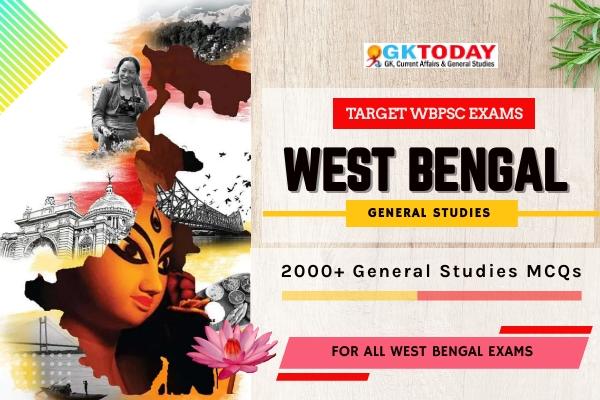States PCS: West Bengal GK Questions for WBPSC Examinations
For all West Bengal Public Service Commission (WBPSC) exams including WBCS, JE, AE, and other state-level competitive examinations.
1. The government has recently launched a Green – Ag project for transforming Indian agriculture, which of the following statements is/are true regarding this scheme?
- This Project is a collaboration of Indian Government and FAO
- Funding for Green – Ag project would be coordinated by the Global Environment Facility (GEF)
- This project mandates to spur the second green revolution in India in Eastern Ganga Belts especially Bihar and West Bengal
Select the correct option from the codes given below:
[A] Only 1 & 3
[B] Only 2 & 3
[C] Only 1 & 2
[D] 1, 2 & 3
Show Answer
Correct Answer: C [Only 1 & 2 ]
Notes:
Statement 1 is correct – The “Green – Ag-Transforming Indian Agriculture for global environment benefits and the conservation of critical biodiversity and forest landscapes” is in collaboration with the Food and Agriculture Organization (FAO) of the UN. Ministry of agriculture would be its nodal body ad MOEFCC would provide necessary help.
Statement 2 is correct- The funding for the scheme would be availed via the GEF (Global Environment Facility) Trust Fund.
Statement 3 is incorrect – The scheme will invest in high-conservation-value landscapes of five States i.e.- 1. Mizoram: Dampa Landscape, 2. Odisha: Similipal Landscape, 3. Rajasthan: Desert National Park Landscape and 4. Uttarakhand: Corbett-Rajaji Landscape. 5. Madhya Pradesh : Chambal Landscape
2. Which of the following state took steps to revitalize the panchayati raj after the recommendations of Ashok Mehta Committee?
1. Karnataka
2. West Bengal
3. Andhra Pradesh
4. Maharashtra
Select the correct option from the codes given below:
[A] Only 1 & 2
[B] Only 1 & 3
[C] Only 1, 2 & 3
[D] 1, 2, 3 & 4
Show Answer
Correct Answer: C [Only 1, 2 & 3]
Notes:
After the fall of Janta government three states of Karnataka, West Bengal and Andhra Pradesh took steps to revitalise the panchayati raj, keeping in view some of the recommendations of the Ashok Mehta Committee.
3. According to the scholars,how many racial elements came together to form Bangalee race?
[A] 5
[B] 4
[C] 3
[D] 6
Show Answer
Correct Answer: C [3]
Notes:
There were three major racial elements which
came together to form the Bengalee race– they were the Dravidians, the Mangolian
tribes and the Aryans.
4. Who was Suhma Kingdom originated from?
[A] Bali
[B] Karna
[C] Suhma
[D] Sugrib
Show Answer
Correct Answer: C [Suhma]
Notes:
In the Mahabharata, it is stated that the Suhmas originated from Suhma, the son of Bali. It was a vast land lying on West of the Bhagirathi extending upto the sea was included within
the territorial jurisdiction of the Suhma country wherein lived the Suhmas.
5. Who was titled as Sakalauttarapathanatha?
[A] Ashoka
[B] Kanishka
[C] Harshavardhana
[D] None of the above
Show Answer
Correct Answer: C [Harshavardhana ]
Notes:
When Harshavardhana was defeated by Pulkesin II (western Chalukyan King of Badami) on the banks of Narmada. Pulkesin II bestowed the title of “Sakalauttarapathanatha’’, meaning “Lord of the entire north”, upon him.
6. Who are the Chedis, the Vidarbhas, the Satvatas descendants of?
[A] Varmanas
[B] Vardhanas
[C] Yadavas
[D] Mauryas
Show Answer
Correct Answer: C [Yadavas]
Notes:
Amongst the Yadava clans mentioned in ancient Indian literature, most Yadava clans, which include the Chedis, the Vidarbhas, the Satvatas, the Andhakas, the Kukuras, the Bhojas, the Vrishnis and the Shainyas are believed to have descended from Kroshtu or Kroshta, younger son of Yadu.
7. Which are the twin capitals built in Bengal by Turkish Sultanate?
[A] Gaur & Pandua
[B] Patuliputra & Hedua
[C] Malda & Murshidabad
[D] None of the above
Show Answer
Correct Answer: A [Gaur & Pandua]
Notes:
Islam came to Bengal in the thirteenth century and a Turkish Sultanate
came to be established with its twin capitals at Gaur (also called
Laxmanavati, the capital of the Sen dynasty [c. 1095–1645], or Lakhnaoti)
and Pandua, both in Malda district of West Bengal.
8. Anandadeva constructed his new capital at–
[A] Manipura
[B] Bishnupura
[C] Vasantapura
[D] Nabadwip
Show Answer
Correct Answer: C [Vasantapura]
Notes:
The most significant information supplied by the first record is about the newly constructed capital at Vasantapura. Apparently, the old capital had to be abandoned due to attacks of invaders. Anandadeva, the third and greatest ruler of the dynasty, issued the grant in his 39th regnal year from this new capital.
9. Who was the ruler of Pratapgarh kingdom?
[A] Kalindi Sheikh
[B] Sherbahadur
[C] Bazid
[D] Majidi
Show Answer
Correct Answer: C [Bazid]
Notes:
In the northeastern Barak Valley, the ruler Bazid of the Pratapgarh Kingdom declared himself as a Sultan on par with the Bengali Sultan. This invited the retribution of Alauddin Hussain Shah, who dispatched Surwar Khan (a convert to Islam from Hinduism) to suppress the newly formed sultanate in Pratapgarh.
10. Tughlaq Nama was written by–
[A] Amir Qyeedi
[B] Syeed Javeri
[C] Shah Kazim Qadri
[D] Amir Khusrau
Show Answer
Correct Answer: D [Amir Khusrau]
Notes:
Tughlaq Nama (Book of the Tughlaqs), 1320 – a historic masnavi of the reign of the Tughlaq dynasty written by Amir Khusrau.

